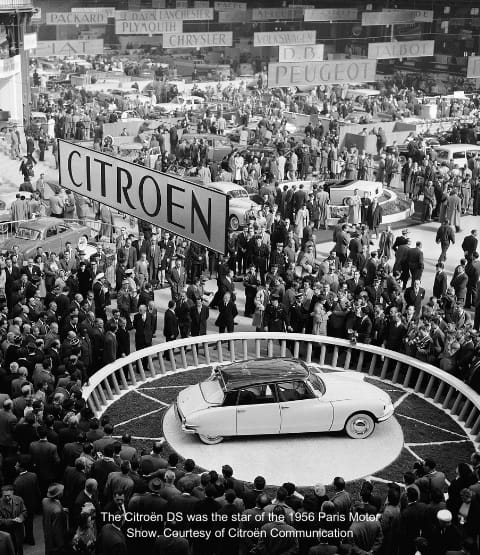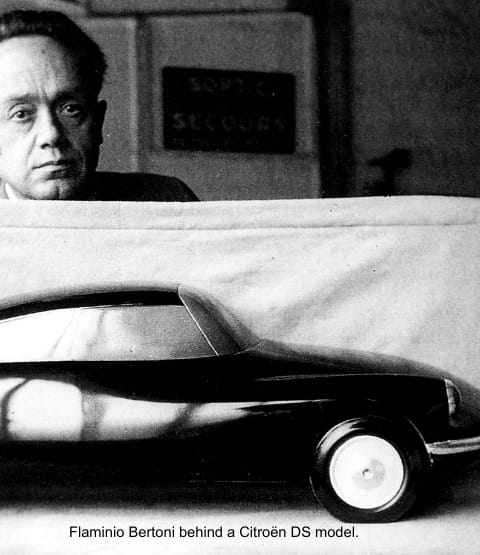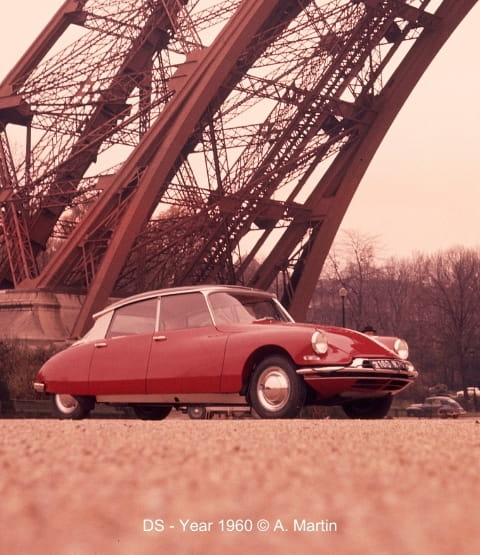DS: 70 years a work of art
DS: icon of the century
In the French car trade, it is often said that there is a ‘before’ and an ‘after’ 6 October 1955.

DS 19: a first, eye-catching appearance
A revolution blending design and innovation
Coming just several years after the end of the Second World War and at the dawn of the ‘Trente Glorieuses’, the DS stood in stark contrast to the severe monoliths of the pre-war era. It was the symbol of a new, daring France. The result of the VGD (Véhicule de Grande Diffusion - mass-market vehicle) programme launched in 1935 as a logical follow-up to the Traction, the DS's silhouette was inspired by the American trend for streamlining. Soft, enveloping volumes were now the order of the day. The DS was strikingly modern with its pebble-like shape and a host of effects: curved windows, voluptuous wings, frameless doors, jet engine-shaped lights framing a plastic-set roof, streamlined rear wheels, a single-spoke steering wheel sitting on a futuristic dashboard, and so on.
The manufacturer’s industrial ingenuity, which gave free rein to the creativity of designer Flaminio Bertoni, was complemented by technological innovation conceived by André Lefebvre and Paul Magès for the incredible hydropneumatic suspension. This was one of the most original parts of the vehicle: each independent wheel was mounted on an arm connected by a piston to a sphere containing a mixture of pressurised nitrogen and a special liquid, giving the vehicle a level of comfort that had no equal at the time. Add to this the automatic clutch, virtually unknown in Europe, and the front disc brakes activated by a “mushroom” button instead of the traditional brake pedal, and the DS was a machine as unreal as it was breathtaking.
From being the successor to an iconic model, the DS 19 achieved the exploit of becoming a fully-fledged symbol of a new era in automotive history.


A multitude of iconic models
Buoyed by its success, the DS 19 was soon joined by a number of other models. The first of these, the ID 19, came out in 1957 and can be considered in many respects as a less luxurious and modern version of the DS 19. Other versions, with 5 to 8 seats, soon followed. The DS was also a source of inspiration for artists of the time. The famous French coachbuilder Henri Chapron fell in love with the car and adopted it as one of his muses, producing no fewer than 9 different versions, including several sublime cabriolets. But it was another event that brought the DS unexpected publicity. In 1962, when an assassination attempt was made on General de Gaulle at Petit-Clamart, the driver of the presidential DS succeeded in accelerating away and staying on the road, despite burst tyres and a waterlogged surface. When, at the trial of the gunmen, he was asked about any modifications that might have been made to the vehicle, the driver stated that the car was completely standard and fitted with perfectly ordinary tyres.
The years went by, and the innovations kept coming: mechanical gearboxes, a new 83 bhp engine enabling the vehicle to reach 150 km/h, new finishes... But the manufacturer did not stop there and prepared for the future by successively revealing the DS 20 and DS 21. In 1967 at the Paris Motor Show, the DS-ID range was given a final facelift and a new look. Bertoni's final design featured four headlamps in two streamlined headlamp units. On 24 April 1975, the DS ceased production for good. In the space of twenty years, 1,455,746 units were produced.
Almost 70 years after its first appearance, the DS 19 and its many incarnations have found a place in the pantheon of French motoring. The brand's various models remain highly popular among collectors from all walks of life.
In partnership with:


Ready to make you dream again?
The world's finest ephemeral garage dedicated to classic cars is closing its doors... but will be back next year for another exceptional edition! 50 years of the show! Half a century of motoring passion to celebrate together.
The ticket office is open, get your ticket!

